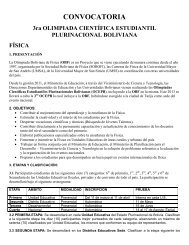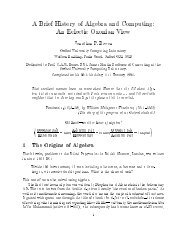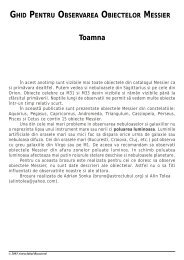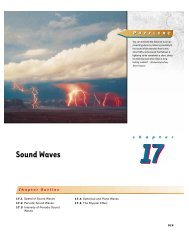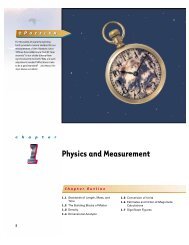Circular Motion and Other Applications of Newton's Laws
Circular Motion and Other Applications of Newton's Laws
Circular Motion and Other Applications of Newton's Laws
Create successful ePaper yourself
Turn your PDF publications into a flip-book with our unique Google optimized e-Paper software.
164 CHAPTER 6 <strong>Circular</strong> <strong>Motion</strong> <strong>and</strong> <strong>Other</strong> <strong>Applications</strong> <strong>of</strong> Newton’s <strong>Laws</strong><br />
Terminal speed<br />
v<br />
(a)<br />
R<br />
mg<br />
v = 0<br />
a = g<br />
v = v t<br />
a = 0<br />
(b)<br />
Figure 6.15 (a) A small sphere falling through a liquid. (b) <strong>Motion</strong> diagram <strong>of</strong> the sphere as it<br />
falls. (c) Speed–time graph for the sphere. The sphere reaches a maximum, or terminal, speed<br />
v t, <strong>and</strong> the time constant � is the time it takes to reach 0.63v t.<br />
Resistive Force Proportional to Object Speed<br />
If we assume that the resistive force acting on an object moving through a liquid<br />
or gas is proportional to the object’s speed, then the magnitude <strong>of</strong> the resistive<br />
force can be expressed as<br />
(6.2)<br />
where v is the speed <strong>of</strong> the object <strong>and</strong> b is a constant whose value depends on the<br />
properties <strong>of</strong> the medium <strong>and</strong> on the shape <strong>and</strong> dimensions <strong>of</strong> the object. If the<br />
object is a sphere <strong>of</strong> radius r, then b is proportional to r.<br />
Consider a small sphere <strong>of</strong> mass m released from rest in a liquid, as in Figure<br />
6.15a. Assuming that the only forces acting on the sphere are the resistive force bv<br />
<strong>and</strong> the force <strong>of</strong> gravity Fg, let us describe its motion. 1 Applying Newton’s second<br />
law to the vertical motion, choosing the downward direction to be positive, <strong>and</strong><br />
noting that we obtain<br />
mg � bv � ma � m (6.3)<br />
where the acceleration dv/dt is downward. Solving this expression for the acceleration<br />
gives<br />
dv<br />
R � bv<br />
�Fy � mg � bv,<br />
dt<br />
dv<br />
dt<br />
� g � b<br />
m v<br />
(6.4)<br />
This equation is called a differential equation, <strong>and</strong> the methods <strong>of</strong> solving it may not<br />
be familiar to you as yet. However, note that initially, when v � 0, the resistive<br />
force � bv is also zero <strong>and</strong> the acceleration dv/dt is simply g. As t increases, the resistive<br />
force increases <strong>and</strong> the acceleration decreases. Eventually, the acceleration<br />
becomes zero when the magnitude <strong>of</strong> the resistive force equals the sphere’s<br />
weight. At this point, the sphere reaches its terminal speed v t, <strong>and</strong> from then on<br />
1 There is also a buoyant force acting on the submerged object. This force is constant, <strong>and</strong> its magnitude<br />
is equal to the weight <strong>of</strong> the displaced liquid. This force changes the apparent weight <strong>of</strong> the sphere by a<br />
constant factor, so we will ignore the force here. We discuss buoyant forces in Chapter 15.<br />
v t<br />
0.63v t<br />
v<br />
τ<br />
(c)<br />
t




